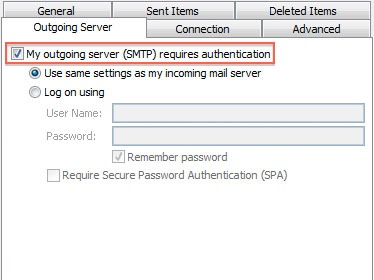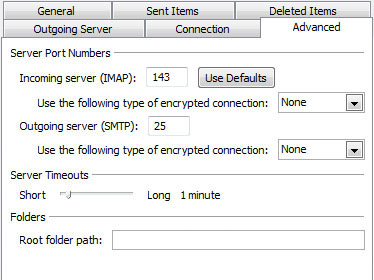Business/Enterprise mails can be configured on various email clients such as Outlook, Outlook Express, Thunderbird, Windows Mail, Windows Live Mail, Apple Mail, Foxmail, etc.
The mail clients listed below contain instructions on how to set up your mail account for the mail clients specified.
Setting up Email Account on Microsoft Outlook 2007
In order to send and receive email using Microsoft Outlook 2007, you need to set up your account as described below –
- Start Microsoft Outlook 2007. Click the Tools menu and select Account Settings…
- On the E-mail tab, click New…
- Fill in all necessary fields to include the following information:
- Your Name: Enter your name as you would like it to appear in the From field of outgoing messages.
- E-mail Address: Enter your full email address ([email protected]).
- Password: Enter your email password.
- Manually configure server settings or additional server types: Select this checkbox and click Next.
- On the prompt to Choose E-mail Service, select Internet E-mail to connect to your POP, IMAP, or HTTP server to send and receive e-mail messages. Click Next.
- In the Internet E-mail Settings dialog, verify your User Information and enter the following additional details:
- Server Information
- Account Type: Select POP3 or IMAP
- Incoming & Outgoing mail server: You can obtain this information from your Email Dashboard. In Dashboard go to Mail > DNS Configuration and POP/IMAP/SMTP records. Or if you are using our DNS service for your domain then you can use: Incoming Mail Server: pop.your-domain-name (eg: pop.demomonkey.org)
Outgoing Mail Server: smtp.your-domain-name (eg: smtp.demomonkey.org)***For IMAP configuration,
Account Type: IMAP
Incoming Mail Server: imap.your-domain-name (eg: imap.demomonkey.org)
Outgoing Mail Server: smtp.your-domain-name (eg: smtp.demomonkey.org)
- Server Information
- Login Information
- User Name: Enter your full username (same as your email address)
- Password: Enter your email password
- Require logon using Secure Password Authentication (SPA): Leave this option unchecked.
- Click More Settings… and select Outgoing Server
- Check the box next to My outgoing server (SMTP) requires authentication and ensure that the option Use same settings as my incoming mail server is selected.
- Click OK and then Next
Usually, the port used for the Outgoing Mail Server/SMTP Service is 25. However, there might be a situation where your ISP might be blocking the use of port 25 for SMTP service. Many ISPs block port 25 in order to minimize the amount of spam sent using their network. If you are facing issues sending mails using the default port 25, you can confirm with your ISP whether port 25 is indeed blocked by them.
To circumvent this, you can use an alternate port 587 for sending mails if port 25 is blocked. Here’s how:
a) In the Tools menu select Options -> Mail Setup and click Email Accounts
b) Select your account and click Change above the list of accounts
c) Click More Settings and then the Advanced tab
d) In the Outgoing server(SMTP) field replace the default port number 25 with the alternate port number 587
e) Click Ok -> Next -> Finish -> Close and then Ok to save the changes
SSL/TLS option has been enabled on our servers. The SSL/TLS option will run on the default ports. That means you do not need to change the port numbers for the SSL/TLS option to work.
Steps to configure TLS/SSL in Outlook 2007
a) Start the Microsoft Outlook program
b) Select the account to change. Highlight your e-mail account, then click Change to open the settings window. (Do not click Repair.)
c) Open the Advanced settings tab. Click the More Settings button, then choose the Advanced tab.
d) In the Advanced tab:
- First, check the box marked This server requires an encrypted connection (SSL)
- Make sure that the Incoming server (POP/IMAP) port number is 995/993
- In the Use the following type of encrypted connection list, choose TLS
- Make sure that the Outgoing server (SMTP) port number is 25/587
e) Click OK to close the “Internet E-mail Settings” window.
That’s it, your account has been setup! When you click on Send/Receive, all your emails will be downloaded by Outlook 2007.
Setting up Email Account on Microsoft Outlook 2010
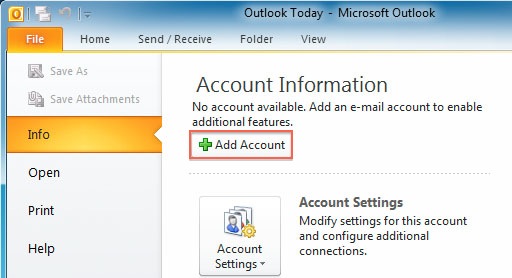
& then click More Settings.** Please note that the Domain Name used for the configuration here is ‘q.com’For Free Email Service / Email Hosting Plans
Incoming & Outgoing mail server: You can obtain this information from your Email Dashboard. In Dashboard go to Mail > DNS Configuration and POP/IMAP/SMTP records. Or if you are using our DNS service for your domain then you can use:
Incoming Mail Server: pop.your-domain-name (eg: pop.demomonkey.org)
Outgoing Mail Server: smtp.your-domain-name (eg: smtp.demomonkey.org)***For IMAP configuration,
Account Type: IMAP
Incoming Mail Server: imap.your-domain-name (eg: imap.demomonkey.org)
Outgoing Mail Server: smtp.your-domain-name (eg: smtp.demomonkey.org)
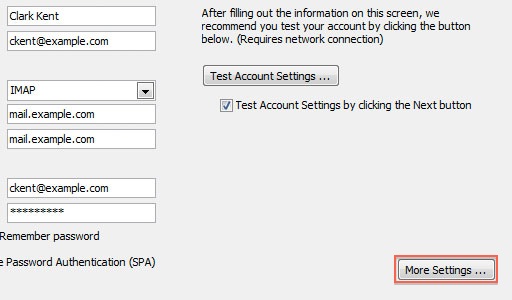
& then put the bullet next to “Use same settings as my incoming mail server”.
to 587, change the encrypted connection to None & then click OK. Tick on Leave a copy of messages on the server as per your preference. ***For POP configuration,
Incoming (POP) Server Port Number: 110
Outgoing (SMTP) Server Port Number: 587***For IMAP configuration,
Incoming (IMAP) Server Port Number: 143
Outgoing (SMTP) Server Port Number: 587
Click Next.
You can try sending a Test Email and Test the Accounts Settings.

Setting up Email Account on Microsoft Outlook 2013
- When you first open Outlook, it will provide a “Welcome to Outlook 2013” message, click the Next button.
- The next screen will ask “Do you want to set up Outlook to connect to an email account?” choose Yes and click the Next button.
- On the Auto Account Setup menu, select the option for Manual setup or additional server types, then click next.

On the Choose Service menu, click the POP or IMAP option then click the Next button.
You will then see the POP and IMAP Account Settings menu, fill in the fields.
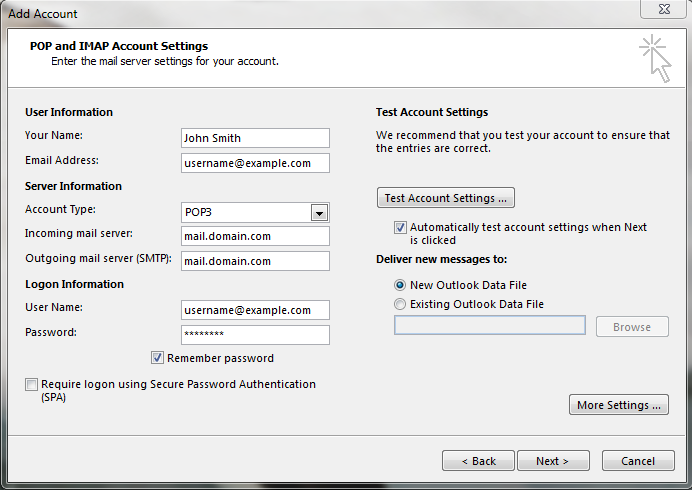
Below is a description of the fields:
| Option | Description |
|---|---|
| Your Name | Enter the name you want people you email to see, such as John Smith |
| Email Address | Enter your full email address, such as [email protected] |
| Account Type | Choose if you want to use POP or IMAP. By default, POP downloads and removes your emails from the server, while IMAP leaves them on the server. In our tests, we are setting up a POP account. |
| Incoming mail server |
Standard settings: imap.domain.com OR pop.domain.com (Replace domain.com with your actual domain)
|
| Outgoing mail server (SMTP) | Standard settings: smtp.domain.com (Replace domain.com with your actual domain) |
| User Name | Enter your full email address, such as [email protected] |
| Password | Enter the password for this email address. |
| Remember password | I recommend checking this box, so Outlook will save your password. |
| Require logon using (SPA) | Do not check this box. |
- Click the More Settings button.
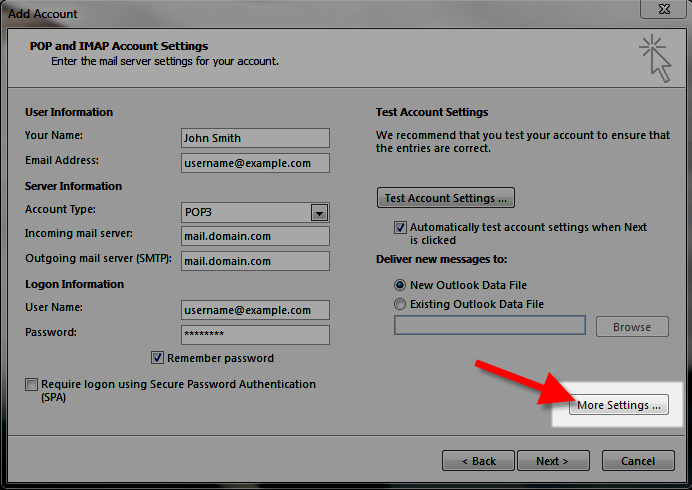
- Click the Outgoing Server tab.
Check “My outgoing server (SMTP) requires authentication“.
Check “Use same settings as my incoming mail server“.
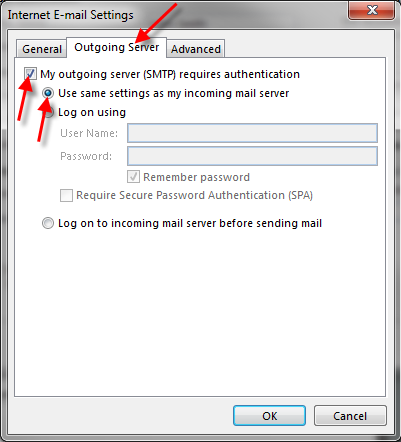
- Click the Advanced tab. Enter your settings, below is a description of the available options.
Option Description Incoming Server Choose your preferred settings, below are the available options.Standard (POP3): 110Standard (IMAP): 143SSL (POP3): 995SSL (IMAP): 993This server requires an encrypted connection (SSL) Click this if you are using the SSL option. Outgoing Server Standard: 25* or 587SSL: 465*Often times, ISP’s will block this port for use with their email. You may want to consider using port 587, or the secure settings.Use the following type of encrypted connection: Standard: NoneSSL: SSL - Click the OK button.
- Click the Next button, Outlook will test the account settings.
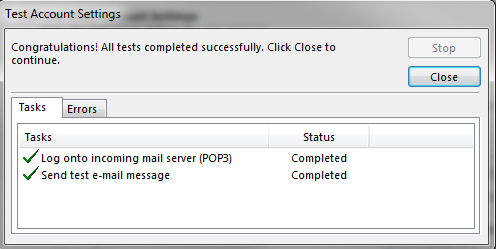
- You will see two tasks: Log onto incoming mail server, and, Send a test e-mail message. When they are complete, click on the Close button.
- You will see a message stating “You’re all set!” click the Finish button.
Setting up Email Account on Microsoft Outlook Express
Follow the steps detailed below to use Microsoft Outlook Express 6.0 to send/receive emails from your email account.
- Start Outlook Express 6.0. On the Tools menu, click Accounts…
- In the Internet Accounts dialog box, click Add, and then click Mail…
- In the Display name box, type the name that you would like others to see when you send a message and then click Next.
- In the E-mail address box, type the email address for the account that you are using (for example, [email protected]) and then click Next.
- Under E-mail Server Names, click the appropriate incoming e-mail server type POP3/IMAP (Post Office Protocol version 3 [POP3] is the default type)
- Incoming & Outgoing mail server: Incoming & Outgoing mail server: You can obtain this information from your Email Dashboard. In Dashboard go to Mail > DNS Configuration and POP/IMAP/SMTP records. Or if you are using our DNS service for your domain then you can use: Incoming Mail Server: pop.your-domain-name (eg: pop.demomonkey.org)
Outgoing Mail Server: smtp.your-domain-name (eg: smtp.demomonkey.org)***For IMAP configuration,
Account Type: IMAP
Incoming Mail Server: imap.your-domain-name (eg: imap.demomonkey.org)
Outgoing Mail Server: smtp.your-domain-name (eg: smtp.demomonkey.org)
- Incoming & Outgoing mail server: Incoming & Outgoing mail server: You can obtain this information from your Email Dashboard. In Dashboard go to Mail > DNS Configuration and POP/IMAP/SMTP records. Or if you are using our DNS service for your domain then you can use: Incoming Mail Server: pop.your-domain-name (eg: pop.demomonkey.org)
- Now, type your complete email address and password in the respective fields and click Next.
- The following window will display the success message – Congratulations, you have successfully entered all of the information required to set up your account. To save these settings, click Finish.
- Open the Internet Accounts dialog box referring to steps 1 and 2. In the Mail view, you will see the Account you have just added. Now you need to click Properties.
- Under the Servers tab, you need to check the checkbox My server requires authentication placed under Outgoing Mail Server. Once this is done, click Apply.
Usually, the port used for the Outgoing Mail Server/SMTP Service is 25. However, there might be a situation where your ISP might be blocking the use of port 25 for SMTP service. Many ISPs block port 25 in order to minimize the amount of spam sent using their network. If you are facing issues sending mails using the default port 25, you can confirm with your ISP whether port 25 is indeed blocked by them.
To circumvent this, you can use an alternate port 587 for sending mails if port 25 is blocked. Here’s how: a) In Outlook Express, on the Tools menu, click Accounts
b) Select the email account you wish to modify and click Properties
c) Under the Advanced tab, replace the default port number 25 with the alternate port number 587 in the field provided for Outgoing mail (SMTP)
d) Click OK and then Close to save the changesANNOUNCEMENT
SSL/TLS option has been enabled on our servers. The SSL/TLS option will run on the default ports. That means, you do not need to change the port numbers for the SSL/TLS option to work.
Steps to configure TLS/SSL in Outlook Express
a) Go to Outlook Express -> Tools -> Account
b) Click on Mail tab -> highlight your email account -> Properties
c) Click on “Advanced” tab, Server Port No. for Outgoing Mail SMTP change to 25/587
d) Server Port No. for Incoming Mail POP3 is 995 and IMAP at 993
e) Check both the “This server require a secure connection (SSL)”
f) Click OK and Close the “Account” Window.
Your setup is complete. When you click on the Send/Receive button, your email will be downloaded by Outlook Express.
Setting up Email Account on Thunderbird
- Open up your Thunderbird email client onto your desktop
- In the left-hand sidebar you will see a Local Folders. Click on the selection and the right-hand panel will offer you several options. Click on the Create A New Account option.
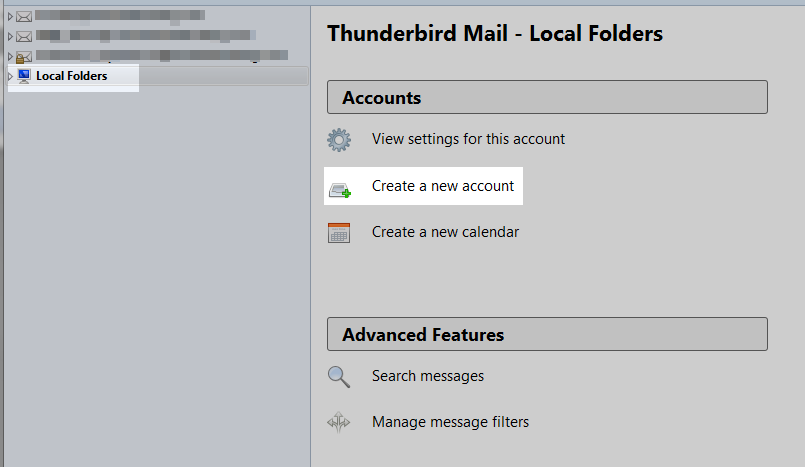
In newer versions of Thunderbird, you will be met with a popup offering a new email account from a few sponsors. You simply need to click the button at the bottom entitled Skip this and use my existing email!
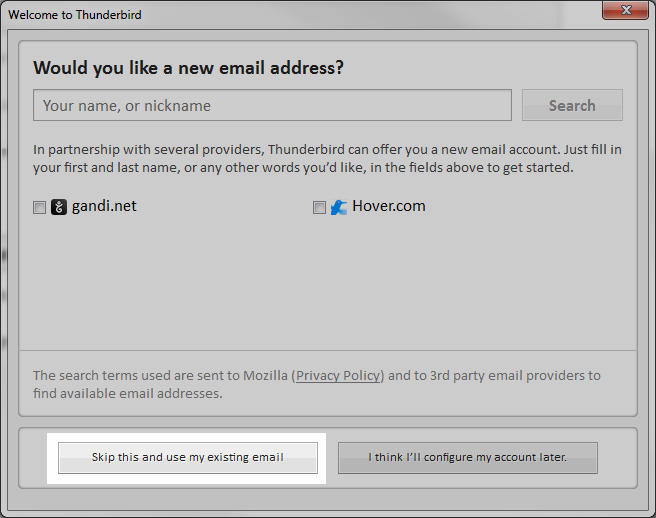
You are now taken to a page where you will enter your existing email information. After entering the information, click on the Continue button at the bottom of the page.
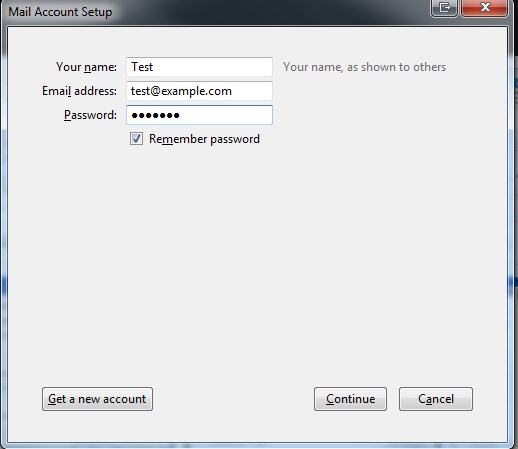
- Thunderbird will now try and find standard connection information to connect the email account. It is best to configure this information yourself by clicking the Manual Config button found at the bottom. Be sure to select the incoming protocol you wish to use (IMAP or POP3). You can read about the differences here. Generally speaking, IMAP is best if you plan on checking the email from multiple devices.
- This is the manual configuration page, where you will set up the incoming and outgoing servers and their respective ports. Once you have entered your settings, hit the Re-test button. If the settings are correct, the Done button will become available. Click it to move on to the next step.
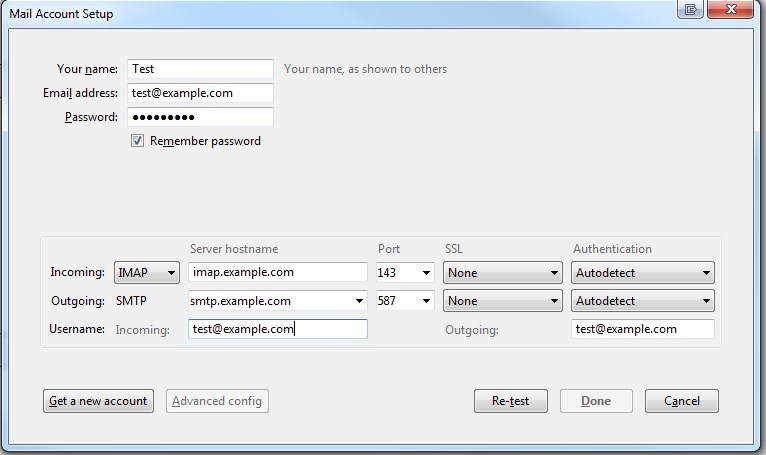
| Server Hostname | You will need to know the server name to the email company you are using. We use smtp.<domain-name>.com where domain-name is your registered domain name.Others may use imap.mail.servername.com or pop.mail.servername.com, which are fairly standard. | ||||||||||||||||
|---|---|---|---|---|---|---|---|---|---|---|---|---|---|---|---|---|---|
| Port | Port number will change depending on your IMAP/POP choice as well as your SSL choice. Use the table below to determine which port number to use.
|
||||||||||||||||
| SSL | This is where you set your encryption settings.
|
||||||||||||||||
| Authentication |
|
||||||||||||||||
12. If you did select the normal (unencrypted) settings, you will be presented with a popup telling you that the email connection to the server is unencrypted. You can check the I understand the risks checkbox and then click the Done button to continue.
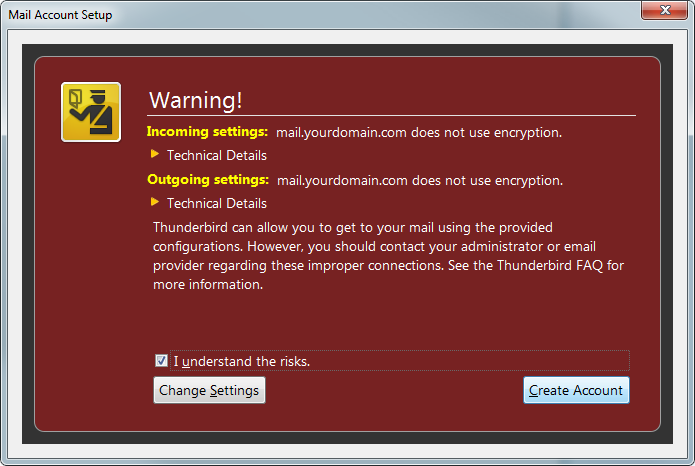
That should complete the process of adding an email address to the Thunderbird email client. You should now see your new email address in the left hand sidebar. That means it is ready for use!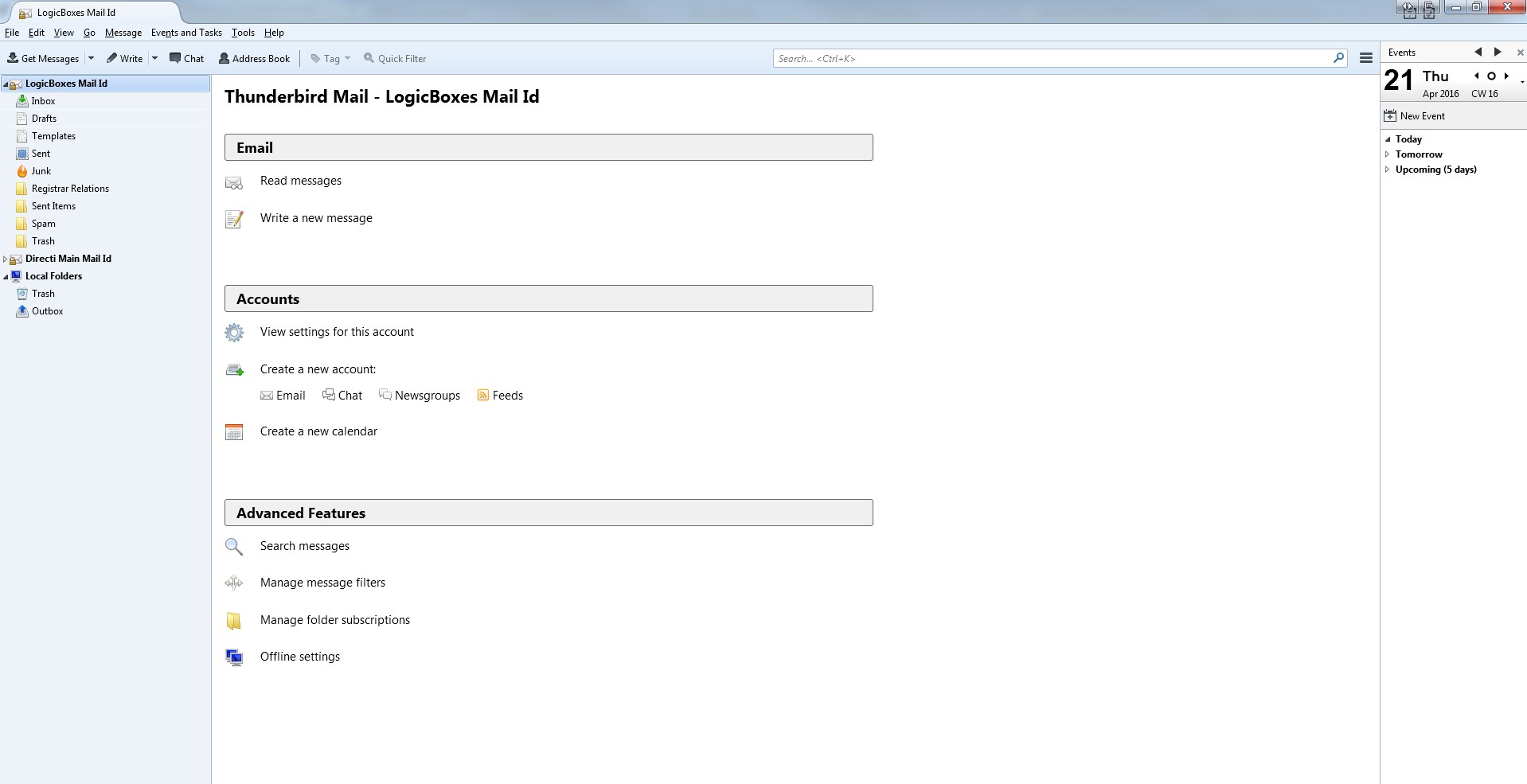
Setting up Email Account on Windows Live Mail
- Start Windows Live Mail, click on the Accounts tab and then the Email button.
2. Enter the email address you wish to add, the email address password and a preferred display name. Check the Manually configure server settings option.
Once these details have been entered click on the Next button.
Please note: You can now choose between using POP3 or IMAP. To find out more about these protocols check out this FAQ.
3. Choose either POP or IMAP from the drop-down box. You will now need to enter imap.domain-name.com or pop.domain-name-com as the server address
The port should be set to 143 for IMAP or 110 for POP3.
The port should be set to 993 for IMAP or 995 for POP3 (Secure connectivity).
Check the option Requires a secure connection (SSL). If using the above ports.
Leave the Authenticate using the option as Clear text.
Finally, enter the log-on username which is the email address you are adding.
4. Enter smtp.123.com OR smtp.<domain-name>.com as the outgoing server address and set the port to 587. Check both the Requires a secure connection (SSL) and Requires authentication options.
Once all these details have been entered click on the Next button.
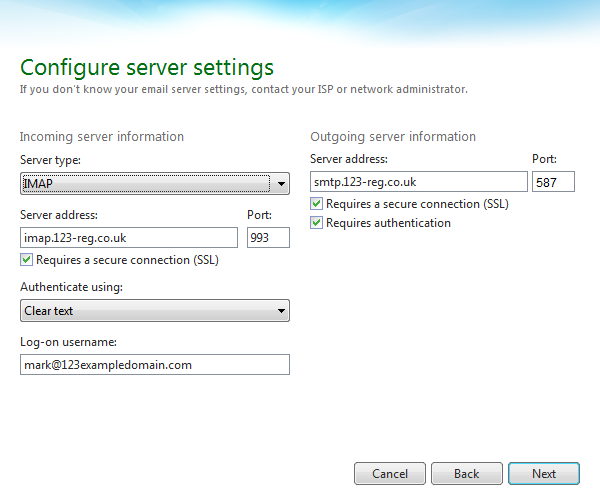
5. Your account has been added and you can click on the Finish button.
6. That’s it, your now ready to start sending and receiving email straight away.
Setting up Email Account on Apple Mail (version 3.6 Leopard):
Follow the steps detailed below to use Apple Mail (Leopard) to send/receive emails from your Email account:
- Go to the Mail Setup Window and choose Add Account from the File menu
- In the Add Account box, fill in all the necessary fields:
- Full Name: Enter your name as you would like it to appear in the From field of outgoing messages
- Email Address: Enter your full email address ([email protected])
- Password: Enter your email password
- Deselect the checkbox next to Automatically set up account
- Click Create
- Fill in the following Incoming Mail Server information:
- Account Type: Select IMAP/POP
- Incoming server: You can obtain this information from your Email Dashboard. In Dashboard go to Mail > DNS Configuration and POP/IMAP/SMTP records. If you are using our DNS service then you can directly use for POP pop.your-domain-name (eg: pop.demomonkey.org)and for IMAP imap.your-domain-name (eg: imap.demomonkey.org)
- Username: Enter your full username (same as your email address)
- Password: Enter your email password
- Click Continue
- Enter the following Outgoing Mail Server information:
- Outgoing Mail Server: Outgoing mail server: You can obtain this information from your Email Dashboard. In Dashboard go to Mail > DNS Configuration and POP/IMAP/SMTP records. If you are using our DNS service then you can directly use smtp.your-domain-name (eg: smtp.demomonkey.org)
- Select the box next to Use Authentication
- Username: Enter your full username (same as your email address)
- Password: Enter your email password
- Click Continue
- Verify your Account Summary and click Create
To circumvent this, you can use an alternate port 587 for sending mails if port 25 is blocked. Here’s how:
- Open the Preferences window and go to Accounts
- Select your account from the existing list of accounts and click Server Settings
- Under the Server Port field enter the port number as 587
- Enter your email address as your username and your password in the respective field and click Ok
Steps to configure TLS/SSL in Apple Mail
a) From the menu bar select “Mail > Preferences…”
b) Click on “Accounts” and then select your POP/IMAP account. Click on the “Advanced” tab. Check the box next to “Use SSL” and make sure the port number is 995/993.
c) Now select the “Account Information” tab, and click on the arrow to the right of “Outgoing mail Server (SMTP)”.
d) Select “Edit SMTP Server List…”
e) Under the “Advanced” tab:
- Select “Use Default ports (25, 465 587)”
- Check “Use Secure Sockets Layer (SSL)”
- For “Authentication”, select “Password”
- For “User Name”, enter your email username
- For “Password”, enter your SMTP password
f) Click “OK” and exit out of the “Accounts” screen.
That's it, your account has been setup! You may now send and receive all your emails using Apple Mail 3.0 (Leopard)
Setting up Email Account on Apple Mail (version 4.0):

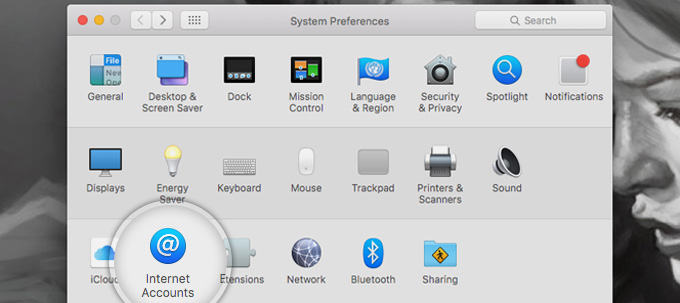


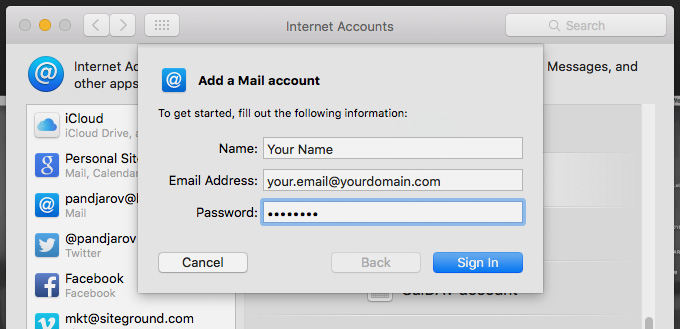
6. Now, you have to fill in the server settings for your email account:
- Email Address: – should be pre-filled with the value you’ve entered in the previous screen;
- Username: – enter your full email address as username. It will be used both for the incoming and outgoing connection;
- Password: – enter the password for your email account;
- Account Type: – it’s set to IMAP by default. Unless you specifically want to use POP3, please leave it that way;
- Incoming Mail Server: – add mail.yourdomain.com unless you have a specific MX records configuration for your domain name;
- Incoming Mail Server: – same as the incoming server;
Once you fill in all the details, press Sign In to proceed.
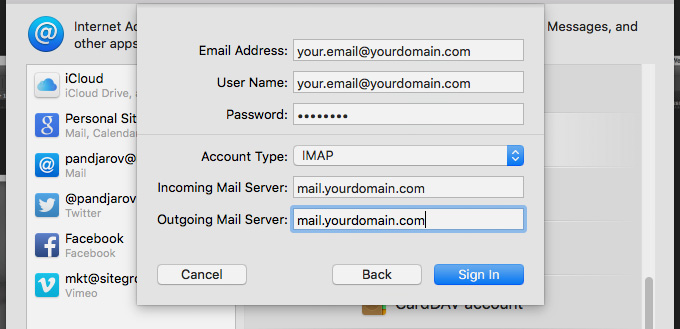
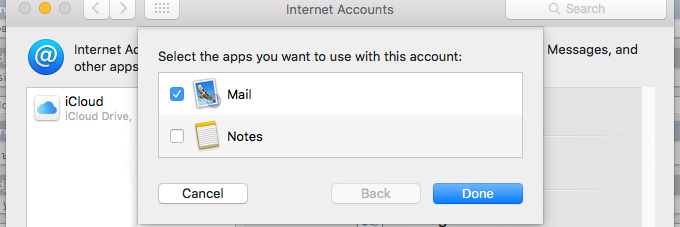
Setting up Email Account on Apple Mail (version 8 onwards):
Before You Begin
Before you set up an email, make sure you have both the incoming (POP and IMAP) and outgoing (SMTP) server settings for your email provider. The settings are available from your email service provider.
Add Email Account
There are two paths to setting up email accounts in the Mac OS:
• Set up the Mail application for the first time.
• Add additional email accounts.
When you get to the Incoming Mail Server step, the directions are the same from that point forward.
Add First Account
The directions in this section are for setting up an email account for the first time. Follow these steps to set up a new email account.
3. From the main Mac screen, hover over the dock to display the application icons.
4. Click the Mail icon. The Add Account dialog box appears.

5. In the Add Account dialog box, type the appropriate information in the corresponding fields. The
fields include:
• Full Name.
• Email Address.
• Password.

Add Additional Account
If you have already added one email account, the directions in this section are for adding more email accounts. Follow these directions to add additional email accounts.
1. From the main Mac screen, hover over the dock to display the application icons.
2. Click the Mail icon. The mail application appears.
3. From the menu bar, click Mail > Preferences. The Accounts dialog box appears.
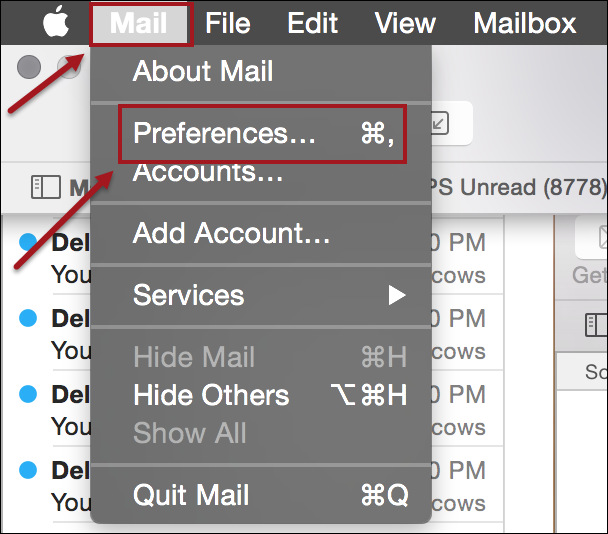
4. On the Accounts dialog box, click the plus sign.
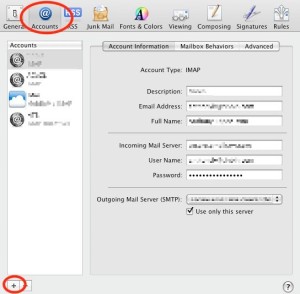
The Choose a mail account to add dialog box appears.
Add Account Information
Whether it’s the first time or you are adding a second or third account, the directions are the same from this point forward.
1. On the Choose a mail account to add dialog box, click the Add Other Mail Account radio button.
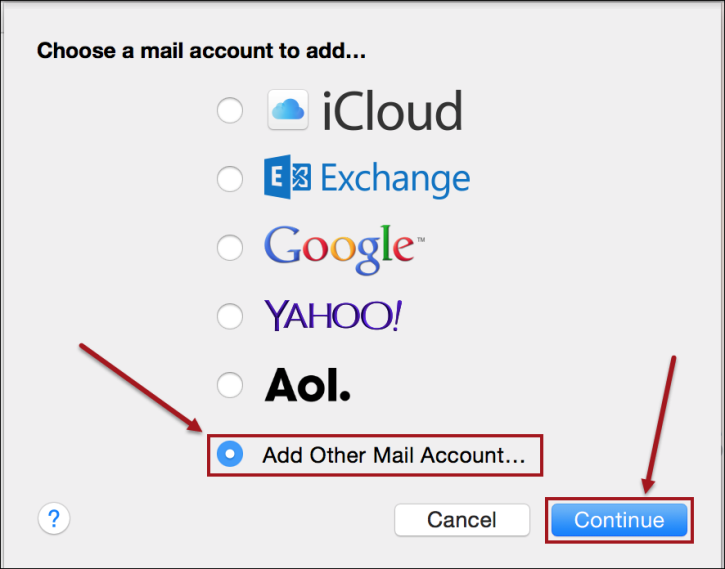
2. Click Continue. The Add a Mail Account dialog box appears. The Full Name field is with your full name.

3. In the Add a Mail Account dialog box, in the Email Address and Password fields, type the corresponding information.
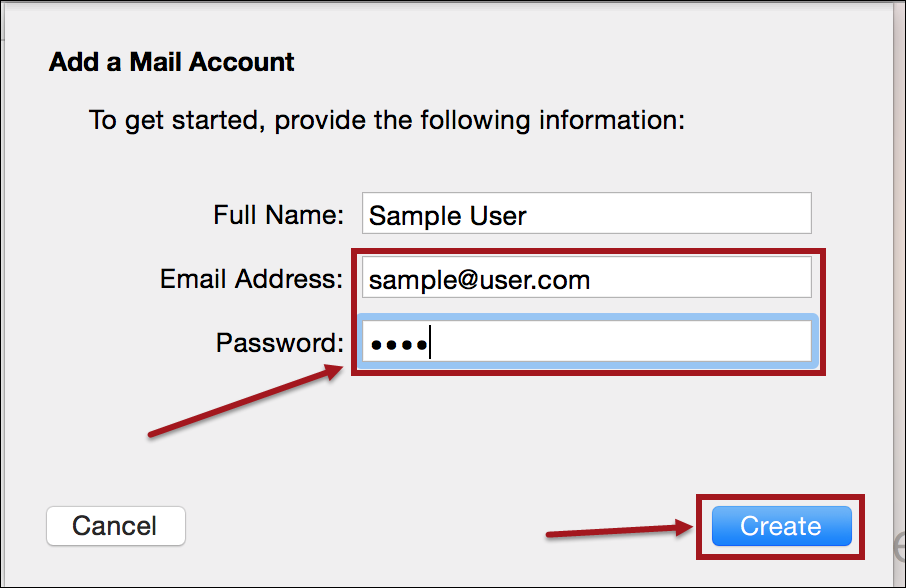
4. Click Create. The Incoming Mail Server Info screen appears.
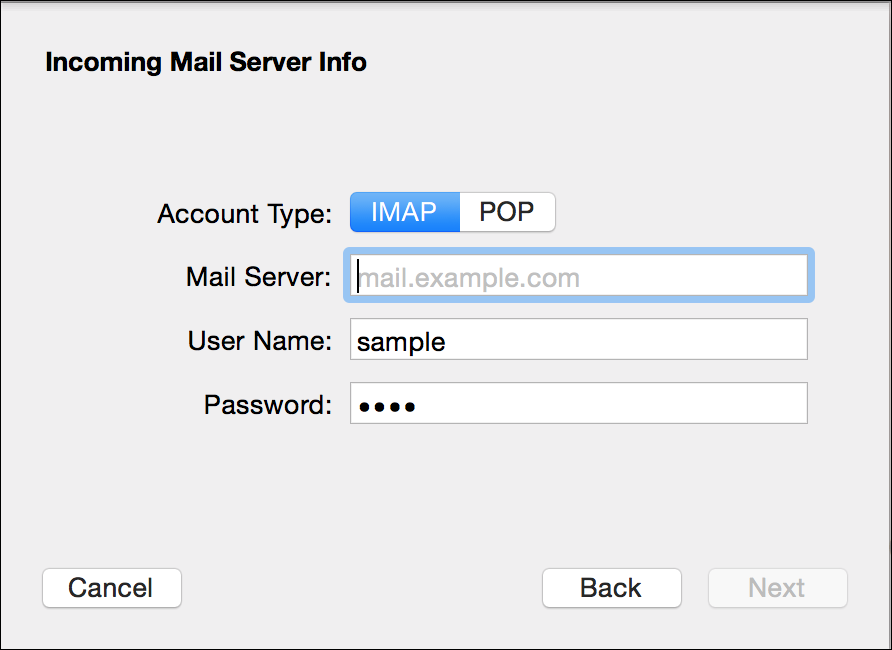
Setup IMAP
When the Incoming Mail Server Info dialog box appears, the IMAP fields appear by default. Follow these directions to set up IMAP.
1. In the Incoming Mail Server dialog box Mail Server, User Name, and Password fields, type the corresponding information.
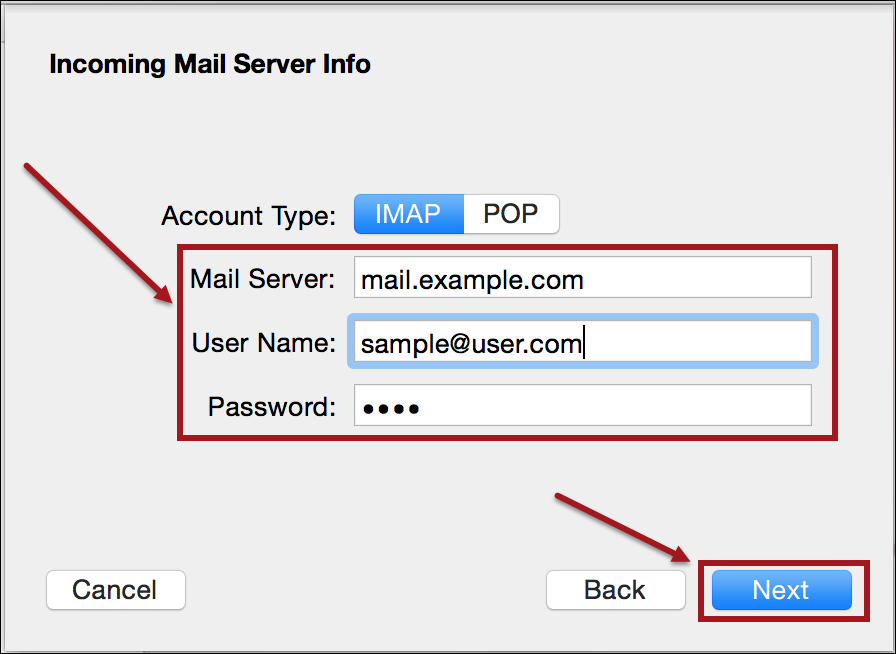
2. Click Next. The Outgoing Mail Server Info dialog box appears.
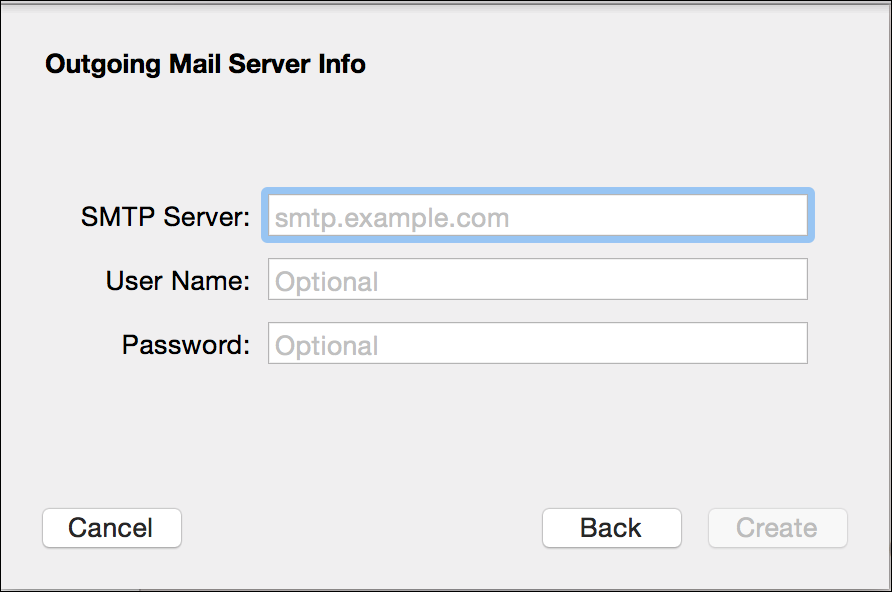
3. In the Outgoing Mail Server Info dialog box SMTP Server, User Name, and Password fields, type the corresponding information.
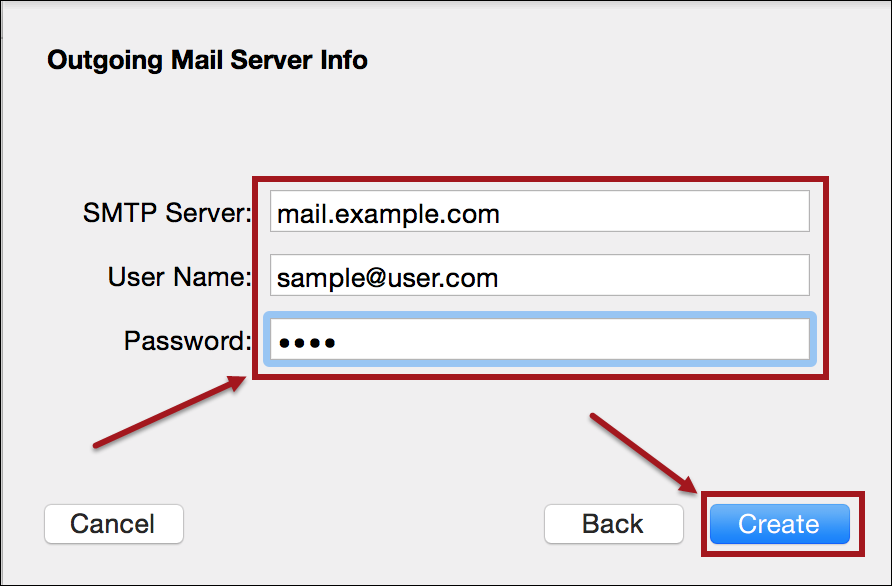
4. Click Create. The Inbox appears and the new email account is created.





